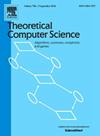Instance-optimal information-based voting
IF 0.9
4区 计算机科学
Q3 COMPUTER SCIENCE, THEORY & METHODS
引用次数: 0
Abstract
The classical Condorcet Jury Theorem considers a voting scenario in which there exists a candidate whose election would be ideal for each voter; each voter, though, has only a limited understanding of the world and is thus unable to determine exactly who this candidate is. The main question in this scenario is whether the voters, acting individually, can cast their ballots so that the unknown optimal candidate wins the election, and the welfare of the group of voters is maximized.
In this setting, each candidate is represented by a known probability distribution over signals about the world that the voters can perceive, that is, over bits. One of these candidates is chosen (secretively, by an adversary) to be the ideal candidate. Afterwards, each voter samples this unknown candidate's distribution once and casts a ballot with the hope that the unknown ideal candidate wins the election.
In this paper, we consider the famous Condorcet voting system, as well as some of its variants. First, we give a positive answer to an open question of Chierichetti and Kleinberg [8], and show that, with Condorcet voting, there exists a uniform voting strategy that makes the group of voters succeed with probability provided that voters take part in the election — here, is the minimum total variation distance between the distributions of two candidates.
We also give a uniform voting strategy for the Copeland voting system (a variant of Condorcet) that makes the group succeed with probability with voters, where is the minimum Hellinger distance between the distributions. Our uniform Copeland strategy, then, is an instance-optimal hypothesis testing algorithm: constants aside, the strategy is as efficient as the optimal omniscient algorithm which determines the unknown candidate after having directly observed each of the signals perceived by the voters. Then, we “derandomize” our uniform Copeland strategy, and obtain a Condorcet strategy that achieves instance-optimality at the cost of losing uniformity; finally, we prove that this loss of uniformity is necessary: no uniform Condorcet strategy can achieve instance-optimality, in general.
Thus, the right voting strategies let these classical combinatorial voting systems attain the same efficiency of centralized, optimal, hypothesis testers.
基于信息的实例最优投票
经典的孔多塞陪审员定理考虑了这样一种投票情况:存在一个候选人,其当选对每个选民来说都是最理想的;但每个选民对世界的了解都很有限,因此无法确定这个候选人到底是谁。在这种情况下,每个候选人都由一个已知的概率分布来表示,这个概率分布是关于选民所能感知到的世界的信号,也就是关于比特的信号。在这些候选者中,(由对手秘密地)选择一个作为理想候选者。之后,每个投票人都会对这个未知候选人的分布进行一次采样,并投出一张选票,希望这个未知的理想候选人赢得选举。在本文中,我们将考虑著名的康德赛特投票系统及其一些变体。首先,我们给出了奇里切蒂和克莱因伯格[8]的一个开放问题的正面答案,并证明在孔多塞投票制下,只要有Θ(ϵtv-2⋅lnδ-1)个选民参加选举,就存在一种均匀投票策略,它能使选民组以 1-δ 的概率成功--这里,ϵtv 是两个候选人分布之间的最小总变异距离。我们还给出了科普兰投票系统(康德赛特的一种变体)的统一投票策略,该策略能使Θ(ϵH-2⋅lnδ-1) 选民组成的小组以 1-δ 的概率成功,其中ϵH 是两个分布之间的最小海灵格距离。因此,我们的统一谷轮策略是一种实例最优的假设检验算法:撇开常数不谈,该策略与最优的全知算法一样高效,后者在直接观察到选民感知到的每个信号后,确定未知的候选人。然后,我们将统一的科普兰策略 "去随机化",得到了一种康德赛特策略,它以失去统一性为代价实现了实例最优;最后,我们证明这种统一性的损失是必要的:一般来说,没有一种统一的康德赛特策略能实现实例最优。因此,正确的投票策略能让这些经典的组合投票系统达到与集中式最优假设检验器相同的效率。
本文章由计算机程序翻译,如有差异,请以英文原文为准。
求助全文
约1分钟内获得全文
求助全文
来源期刊

Theoretical Computer Science
工程技术-计算机:理论方法
CiteScore
2.60
自引率
18.20%
发文量
471
审稿时长
12.6 months
期刊介绍:
Theoretical Computer Science is mathematical and abstract in spirit, but it derives its motivation from practical and everyday computation. Its aim is to understand the nature of computation and, as a consequence of this understanding, provide more efficient methodologies. All papers introducing or studying mathematical, logic and formal concepts and methods are welcome, provided that their motivation is clearly drawn from the field of computing.
 求助内容:
求助内容: 应助结果提醒方式:
应助结果提醒方式:


